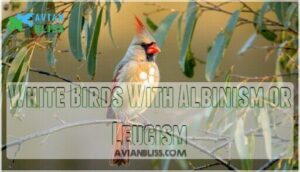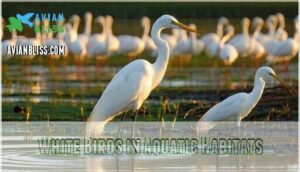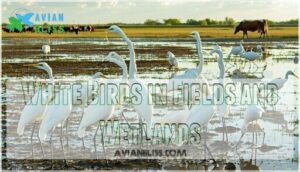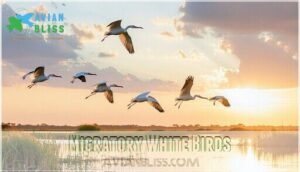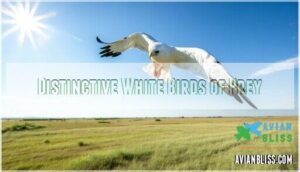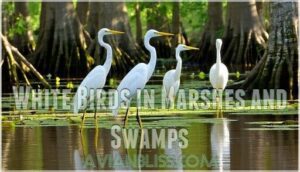This site is supported by our readers. We may earn a commission, at no cost to you, if you purchase through links.

The state hosts everything from common Rock Pigeons and Ring-billed Gulls in parking lots to majestic Great Egrets standing like snowy sculptures in wetlands.
Cattle Egrets with bright yellow bills patrol fields, while Snowy Egrets display delicate breeding plumes in shallow waters.
Coastal areas welcome American White Pelicans and flocks of Snow Geese that transform winter landscapes into living blizzards.
White Ibis probe muddy banks with curved beaks, and rare Trumpeter Swans grace northern lakes.
Each species has distinct field marks and behaviors that’ll help you identify them confidently, with features like bright yellow bills and delicate breeding plumes.
Table Of Contents
- Key Takeaways
- White Birds Found in Texas
- White Birds With Albinism or Leucism
- Common White Birds in Urban Areas
- White Birds in Aquatic Habitats
- Large White Birds With Unique Characteristics
- White Birds in Fields and Wetlands
- Impressive Large White Birds
- Migratory White Birds
- Distinctive White Birds of Prey
- White Birds in Marshes and Swamps
- Frequently Asked Questions (FAQs)
- What are the big white birds in Texas?
- What are the white birds that hang around cows in Texas?
- How rare is it to see a white bird?
- What white birds visit Texas only during winter?
- How do you distinguish juvenile white birds?
- Which white birds are most common in backyards?
- What white birds have the longest lifespans?
- Are there any rare white birds in Texas?
- Conclusion
Key Takeaways
- You’ll spot over a dozen white bird species across Texas year-round, from tiny Rock Pigeons in city parks to massive American White Pelicans with 8-foot wingspans along the coast.
- Great Egrets and Snowy Egrets are your best identification starting points – look for the Great Egret’s yellow bill and towering 4-foot height versus the Snowy Egret’s smaller size and distinctive bright yellow feet.
- Cattle Egrets follow livestock throughout Texas farmland, making them easy to find as they catch insects stirred up by grazing animals with their bright yellow bills.
- Winter brings spectacular migrations of Snow Geese and American White Pelicans from northern breeding grounds, creating some of the most impressive white bird displays you’ll see in Texas.
White Birds Found in Texas
You’ll spot over a dozen white bird species across Texas, from common pigeons in city parks to majestic pelicans along the coast.
These pale-feathered residents and visitors range from tiny songbirds to towering cranes, each with distinct features that make identification straightforward once you know what to look for.
Rock Pigeon
Discovering Rock Pigeons in city parks reveals nature’s ultimate urban adaptation success story.
Their domestication history spans over 5,000 years, making them humanity’s oldest feathered companions.
These remarkable birds showcase incredible plumage variation, from classic blue-gray to pure white forms that catch your eye instantly.
Pure white feathers transform ordinary birds into stunning aerial jewels across Texas landscapes.
Their varied pigeon diet includes everything from breadcrumbs to seeds, helping them thrive as common urban species throughout Texas cities.
You’ll notice their impressive flock behavior as they gather for scattered crumbs and seeds.
Ring-Billed Gull
You’ll often spot this Ring-Billed Gull in texas birds habitats, from coastal areas to inland lakes. Its urban adaptation makes it common around parking lots and landfills.
Here are key identification features:
- Yellow bill with distinctive black ring
- White body with gray wings and back
- Yellow legs and feet
- Juvenile plumage shows mottled brown coloring
- Medium size (16-21 inches long)
These gull species excel at opportunistic feeding habits, scavenging everything from insects to french fries. Their conservation status remains stable, making them reliable subjects for bird identification practice.
They’re also opportunistic feeders, often exploiting human food sources, which is a key aspect of their behavior and ability to thrive in various environments, including areas with human food sources.
Great Egret
The Great Egret towers over Texas wetlands like a feathered skyscraper, reaching nearly four feet tall with its distinctive S-curved neck.
Like a living monument, this Texas giant commands every wetland with elegant authority.
You’ll recognize this Audubon symbol by its bright yellow dagger-like bill and striking green facial skin during breeding season.
These white birds Texas residents love develop elegant breeding plumes that cascade down their backs like silk ribbons.
Great Egrets prefer colony nesting in trees near water, sharing space with other Texas birds.
Their habitat range spans freshwater marshes to coastal Texas birds territories, making them excellent subjects for bird identification practice throughout the state.
Identifying features can be aided by specialized identification products.
Cattle Egret
Anyone can spot these white birds texas species hanging around farms and pastures.
Cattle Egret populations showcase remarkable invasive success through their livestock symbiosis, following cows to catch stirred-up insects.
This texas birds identification favorite displays striking color variations during breeding season—buff-orange plumes crown their heads and backs.
Their range expansion demonstrates impressive agricultural impact, spreading from Africa to colonize Texas by the 1950s.
You’ll recognize their stocky build and shorter neck compared to other egrets.
Detailed guides aid in proper species recognition.
These common white birds prove that partnership pays off in the Texas wildlife community.
Snowy Egret
You’ll recognize Snowy Egrets by their bright yellow feet that stand out like golden slippers against dark water.
These elegant white birds in texas hunt solo in shallow waters, using their yellow feet to stir up fish and frogs.
During breeding season, they develop stunning breeding plumes and red skin patches around their eyes.
Snowy Egrets sometimes create hybrids through hybridization with other herons in mixed colonies.
Birders sometimes utilize a Snowy Egret decoy to attract these birds.
Unlike the larger Great Egret, Snowies are smaller and more active, making them favorites among texas birdwatching enthusiasts along the gulf coast birds communities.
White Ibis
You’ll spot White Ibis wading through Texas wetlands with their curved bills probing muddy bottoms for crayfish and crabs.
These graceful birds sport pure white plumage with black wingtips, pink legs, and distinctive downward-curved beaks perfect for their specialized ibis diet.
- Ibis identification: White body, black wing tips, curved pink bill
- Juvenile plumage: Mottled brown and white coloring until maturity
- Nesting behavior: Builds stick platforms in trees over water
- Conservation status: Stable populations across suitable habitat
- Bird identification tips: Listen for their grunting calls during flight
White ibis texas populations thrive in marshes, swamps, and coastal areas. You’ll often see them foraging in groups, their bills working like precision tools to extract aquatic prey.
These texas birdwatching favorites demonstrate remarkable feeding efficiency, making them fascinating subjects for observation.
American White Pelican
You’ll spot these massive american white pelican soaring over Texas lakes with their impressive 9-foot wingspans.
Unlike their coastal cousins, these white birds prefer inland breeding grounds, building stick nests on secluded islands.
Their unique throat pouch expands like a fishing net, scooping up fish during cooperative feeding frenzies.
During coastal migration periods, flocks create spectacular aerial displays. Thanks to strong conservation status efforts, texas birdwatching enthusiasts regularly enjoy white birds sightings of these remarkable bird species throughout the state’s waterways.
Trumpeter Swan
North America’s heaviest flying bird, the trumpeter swan, graces Texas wetlands with its impressive 30-pound frame and 8-foot wingspan.
These majestic white birds in Texas create lifelong pair bonds while producing distinctive trumpet-like vocalizations that carry across their wetland territories.
- Swan Identification: Pure white plumage with contrasting black bills and feet distinguishes them from other waterfowl
- Breeding Habits: Pairs build large nests from aquatic vegetation, with both parents sharing cygnet-rearing duties
- Migration Patterns: Winter populations arrive from northern breeding grounds, seeking Texas’s shallow freshwater ecosystems
- Conservation Status: Recovery from near-extinction showcases successful reintroduction programs despite ongoing habitat loss threats
- Vocalizations: Trumpet-like calls enable long-distance communication during Texas birdwatching expeditions across their preferred wetlands
Snow Goose
The pure beauty of Snow Goose migration transforms Texas skies each fall and winter.
You’ll spot these pristine white birds in massive flocks across marshes and farm fields.
Their short pink bills and legs distinguish them from other white birds in Texas.
Their diet adaptations help them thrive in agricultural areas, though conservation status remains stable despite changing habitats.
Snow geese breed in arctic breeding grounds, then follow ancient migration patterns southward.
Ross’s Goose
Looking for these small Arctic travelers? Ross’s geese are white birds in texas that stand out with their stubby pink bills and compact size.
During bird migration seasons, you’ll spot flocks mixing with snow geese in wetlands and farm fields. These hardy travelers journey from arctic breeding grounds to Texas, covering thousands of miles twice yearly.
Climate change has boosted their population increase, expanding their habitat use across more areas. Unlike their larger snow goose cousins, Ross’s geese have shorter necks and rounder heads.
Their conservation status remains stable thanks to protection efforts. Listen for their distinctive koo-koo-koo calls when morph identification gets tricky in mixed flocks, which can be a challenge due to their compact size and stubby pink bills.
White Birds With Albinism or Leucism
Bird-watchers occasionally encounter white-feathered surprises that aren’t naturally white species.
These unusual sightings result from genetic conditions affecting bird plumage coloration.
Albinism genetics cause complete melanin absence, creating entirely white feathers with pink or red eyes.
This rare condition affects less than 1% of wild populations.
Leucism causes partial pigment loss, producing patchy white sections while maintaining normal eye color.
Both conditions create bird identification challenges since affected birds don’t match field guide descriptions.
Texas birders report these leucistic and albino species most frequently:
- Northern Mockingbird with white patches
- Great Blue Heron showing partial albinism
- American Robin displaying leucistic markings
- Northern Cardinal with white feathering
Albino survival rates drop substantially due to reduced camouflage and vision problems.
Leucistic birds fare better since their eyes function normally, though both face mating difficulties when their altered appearance confuses potential partners.
These conditions significantly impact the birds’ ability to survive and thrive in their natural habitats, making them a fascinating yet rare sight for bird-watchers.
Common White Birds in Urban Areas
City dwellers can spot several remarkable white birds that have mastered Urban Adaptation alongside humans.
Rock pigeons lead this group, displaying impressive white plumage variations throughout bird city parks and busy streets.
You’ll find them gathered around City Birdfeeders, where their scavenging behavior helps them thrive on dropped seeds and food scraps.
These adaptable birds excel at Human Interaction, often approaching people without fear in bird human-disturbed areas.
Their Population Dynamics remain stable because they’ve learned to exploit urban food sources year-round.
Ring-billed gulls also frequent city environments, particularly near parking lots and fast-food restaurants.
When observing Nesting Locations, you’ll discover these white birds in texas choose creative urban spots—pigeons nest under bridges and building ledges, while gulls prefer rooftops.
Their success in bird urban areas proves that wildlife can flourish in concrete jungles when they adapt their behaviors to match our bustling lifestyles.
White Birds in Aquatic Habitats
Texas aquatic habitats teem with coastal white birds that showcase remarkable adaptations.
You’ll find great egrets standing motionless in shallow waters, their S-curved necks poised to strike fish with lightning speed. Snowy egrets use their bright yellow feet to stir up prey, while white ibis probe muddy bottoms with curved bills.
These wetland bird diets reflect specialized feeding strategies that help species coexist.
- Great egrets patrol freshwater marshes and saltwater estuaries with patient hunting techniques
- Snowy egrets actively forage in shallow water, using their feet as effective fishing lures
- White ibis congregate in coastal marshes, probing systematically for crustaceans and small fish
- Ring-billed gulls dive and surface-feed near lakes, adapting to both natural and urban water sources
Aquatic bird migration patterns bring seasonal visitors to Texas wetlands, while nesting site selection often centers around protected rookeries.
These birds are often symbols of purity in various cultures.
Conservation challenges include habitat loss and water quality issues affecting these spectacular white birds in Texas.
Large White Birds With Unique Characteristics
Across Texas’s vast waterways, you’ll encounter some of North America’s most impressive large white birds with truly unique characteristics.
The great egret stands as a towering sentinel at over three feet tall, showcasing dramatic plumage variations during breeding season when ornate aigrettes cascade from its back like delicate lace.
These magnificent hunters display lightning-fast spearing techniques that make fishing look effortless.
American white pelican flocks create breathtaking spectacles with their nine-foot wingspans and distinctive bill morphology—that expandable orange pouch can hold three gallons of water.
Their cooperative fishing displays involve synchronized herding of fish into shallow waters.
Trumpeter swans glide like floating royalty, weighing up to thirty pounds with resonant calls carrying over two miles.
Wood storks present striking size comparison contrasts with their massive white bodies, black flight feathers, and unique downward-curved bills perfect for tactile feeding.
Each species exhibits distinct leg coloration—from the great egret’s jet-black stilts to the pelican’s bright orange feet—making identification straightforward once you know what to look for in these remarkable white birds in texas.
White Birds in Fields and Wetlands
Fields and wetlands across Texas showcase fascinating white birds with distinct foraging strategies.
You’ll spot Cattle Egrets following livestock, snatching insects disturbed by grazing animals. Their agricultural impact benefits both farmers and birds through natural pest control. Meanwhile, White Ibises wade through marshes, using curved bills to probe muddy bottoms for crustaceans and small fish.
Key field and wetland species you’ll encounter:
- Great Egret – Stands motionless in shallow water hunting fish
- Snowy Egret – Actively stirs sediment with bright yellow feet
- Cattle Egret – Follows cattle and farm equipment for easy meals
- White Ibis – Probes soft mud with sensitive bill tips
- Species Interactions – Multiple white birds often feed together
Texas bird watching reveals how habitat loss threatens these wetland areas. Supporting wetland conservation protects these remarkable white birds and their specialized feeding behaviors.
Impressive Large White Birds
Giant-wingspan waterfowl command attention across Texas’s inland lakes and reservoirs.
American White Pelicans soar with impressive eight-foot wingspans, their brilliant white plumage creating striking contrasts against blue waters.
These massive birds demonstrate remarkable grace despite their size, gliding effortlessly before diving to capture fish with oversized yellow bills.
Great Egrets stand tall in shallow waters, their elegant necks curved in perfect S-shapes.
During breeding season, these birds develop spectacular aigrettes—ornamental plumes that nearly led to their extinction in the early 1900s.
Conservation efforts have successfully restored populations, making Texas bird watching enthusiasts grateful for protection measures.
Whooping Cranes represent conservation success stories.
Standing five feet tall, these magnificent birds faced near-extinction but recovered through dedicated habitat preservation.
Their distinctive red facial patches and black wingtips make identification straightforward for white birds in Texas observers.
Breeding Behavior varies among species, with pelicans forming large colonies while egrets nest individually.
Habitat Loss remains a Conservation Status concern, though Identification Challenges decrease with size—these impressive birds are hard to miss.
Plumage Variations occur seasonally, particularly during breeding periods when colors intensify dramatically, showcasing their remarkable grace and distinctive features.
Migratory White Birds
What happens when thousands of birds paint the Texas sky white during their epic journeys? You’ll witness one of nature’s most spectacular migrations as these white birds follow ancient flyways to their wintering grounds.
The american white pelican leads this aerial parade, traveling from northern breeding lakes to Texas coastal bays each fall. Their massive wings carry them along established migration patterns that scientists track through flyway conservation programs.
Snow geese arrive in thunderous flocks of 500,000, creating a living blizzard across Texas wetlands and agricultural fields. Climate impacts are shifting these traditional routes, forcing birds to adapt their stopover ecology.
Some species now linger longer in Texas due to changing weather patterns. Texas birdwatching enthusiasts anxiously await these seasonal arrivals, knowing that white birds in Texas signal the changing seasons. The Migratory Bird Treaty Act protects these species.
Conservation efforts focus on protecting critical habitat corridors that support these remarkable migrations, ensuring future generations can witness these awe-inspiring journeys.
Distinctive White Birds of Prey
You’ll find these elegant raptors soaring over Texas grasslands and agricultural areas, where their distinctive white plumage makes them easy to spot against the sky.
Both the Swallow-tailed Kite and White-tailed Kite hunt small prey while gracefully gliding on thermals, though you’re more likely to see the White-tailed Kite year-round in the state.
Swallow-tailed Kite
You’ll spot the swallow-tailed kite gliding gracefully through Texas skies with its signature deeply forked tail.
This aerial acrobat hunts insects and small vertebrates mid-flight, showcasing incredible maneuverability.
These raptors migrate from Central America to breed in southeastern Texas wetlands and forests.
- Plumage patterns: Black-and-white coloring with striking contrasts across wings and body
- Flight acrobatics: Exceptional aerial agility enables precise mid-air prey capture techniques
- Nesting habits: Builds stick nests high in canopy trees near water sources
- Conservation status: Stable populations but vulnerable to habitat loss and deforestation
These Swallowtailed Kite sightings represent some of the most spectacular Texas wildlife birds experiences for texas birdwatching enthusiasts seeking White birds in Texas.
White-tailed Kite
Beyond their graceful flight patterns, White-tailed Kites showcase remarkable hunting techniques that make them stand out among Texas wildlife birds.
You’ll spot these elegant raptors hovering like feathered helicopters over open grasslands, scanning for small mammals below. Their plumage variation includes pristine white underparts contrasting with gray wings and backs.
| Characteristic | Details |
|---|---|
| Field Identification | White head, gray wings, black shoulders |
| Bird Kiting Behavior | Hovers 20-100 feet above ground |
| Nesting Habits | Builds stick platform in tall trees |
| Conservation Status | Stable, recovering from past declines |
These White birds in Texas demonstrate incredible bird hunting behavior, dropping swiftly to capture prey with precision.
Their distinctive whitetailed kite silhouette and aerial acrobatics make identification straightforward for birders exploring Texas plains.
They’re a year-round resident, unlike the migratory Swallow-tailed Kite.
White Birds in Marshes and Swamps
Marsh habitats and swamp ecology create perfect homes for many white birds in Texas.
You’ll find Great Egrets standing motionless in shallow water, their bright yellow bills ready to strike unsuspecting fish.
Snowy Egrets dance through the same waters, using their distinctive yellow feet to stir up prey.
These wetland environments offer abundant food sources but also present predation risks from alligators and snakes lurking below the surface.
Bird marsh habitats support diverse nesting strategies, with many species building stick platforms in nearby trees.
Bird swamp habitats provide year-round shelter for resident species while serving as essential stopover points for migrants.
The conservation status of these wetlands directly impacts white bird populations across Texas, making habitat protection essential for maintaining healthy numbers of these elegant waders.
Some species exhibit elaborate courtship displays during breeding season.
Frequently Asked Questions (FAQs)
What are the big white birds in Texas?
Great Egrets stand nearly four feet tall and you’ll spot them year-round in Texas marshes. These majestic white birds hunt with patience, using their dagger-like yellow bills to catch fish.
What are the white birds that hang around cows in Texas?
You’ll see Cattle Egrets hanging around livestock in Texas. These white birds with yellow bills follow cows to catch insects stirred up by grazing animals.
How rare is it to see a white bird?
White wings won’t surprise you—they’re wonderfully widespread.
You’ll spot white birds regularly since many common species sport snowy plumage.
From gulls to egrets, doves to swans, white‘s nature’s favorite feather color for visibility and temperature control.
What white birds visit Texas only during winter?
You’ll spot Snow Geese and Ross’s Geese migrating south during fall and winter months.
These Arctic breeders travel in massive flocks, creating spectacular aerial displays across Texas skies before continuing their journey.
How do you distinguish juvenile white birds?
Look for differences in bill color, leg color, and plumage patterns.
Juvenile Little Blue Herons stay white with pale greenish legs and black-tipped bills, while young White Ibises show patchy brown markings throughout their otherwise white bodies.
Which white birds are most common in backyards?
Unlike exotic rarities that steal the spotlight, Rock Pigeons dominate Texas backyards with their variable white plumage.
You’ll also spot Ring-billed Gulls near water sources and occasional Cattle Egrets foraging in grassy areas.
What white birds have the longest lifespans?
Among white birds you’ll encounter, swans live perhaps 20 years in the wild and 50 years or more in captivity.
American white pelicans may live for more than 16 years wild, over 34 years captive.
Great egrets average approximately 15 years in nature.
Are there any rare white birds in Texas?
Yes, you’ll find several rare white birds in Texas.
Whooping Cranes are critically endangered with only about 500 left worldwide.
They winter along the Texas coast.
Trumpeter Swans are uncommon nesters in East Texas, preferring remote wetlands away from people, and are also rare.
Conclusion
Like feathered ghosts haunting Texas skies, white birds in Texas create unforgettable wildlife encounters across diverse landscapes.
You’ll find these stunning species from coastal marshes to urban parks, each offering unique identification challenges.
Whether you’re spotting Great Egrets in wetlands or tracking migrating Snow Geese overhead, field guides and binoculars become your best friends.
Remember that seasonal changes affect plumage and behavior patterns.
Start with common species like Cattle Egrets before tackling rarer finds like Trumpeter Swans for successful birding adventures.

